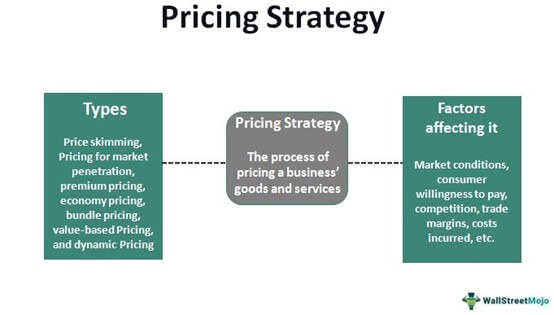The Duty of Competitive Analysis fit Your Pricing Strategy
The Duty of Competitive Analysis fit Your Pricing Strategy
Blog Article
Recognizing Pricing Approaches: An Overview to Boosting Competitiveness
In a progressively affordable landscape, grasping pricing methods is crucial for businesses aiming to boost their market placement. Understanding competitor rates and the mental elements that affect customer actions can develop a nuanced technique to rates that resonates with target audiences.
Value of Rates Approaches
In the competitive landscape of organization, the significance of pricing techniques can not be overemphasized. Pricing acts as a vital bar for organizations, affecting both market positioning and customer assumption. A distinct rates method can enhance profitability, drive sales, and develop an one-upmanship.

Recognizing customer behavior is essential in crafting prices approaches. Insights into price sensitivity, perceived value, and affordable offerings enable businesses to adjust their prices designs appropriately. Furthermore, normal evaluation of rates performance is necessary to react to market dynamics and consumer patterns.
Inevitably, a robust prices strategy is indispensable not just for earnings generation however also for long-term business stability. It forms brand identity, influences customer commitment, and plays a pivotal function in the general advertising and marketing approach. Businesses have to invest time and sources in creating and fine-tuning their rates approaches to grow in an ever-evolving marketplace.
Kinds Of Prices Models
Exactly how work identify one of the most efficient method to price their solutions or items? The answer depends on comprehending various pricing designs, each matched to different market conditions and organization purposes.
One common model is cost-plus rates, where a fixed portion is included in the complete expense of production. This method makes certain that all prices are covered while producing an earnings. On the other hand, value-based pricing concentrates on the viewed value of the product to the customer, permitting companies to bill a premium based on client demand and complete satisfaction.
One more strategy is vibrant pricing, typically used in industries such as travel and friendliness. This design adjusts prices in real-time based on market demand, competitor prices, and other external aspects. Penetration pricing is likewise considerable, where businesses originally set lower rates to go into an open market and gain market share, later raising prices once a customer base is developed.
Lastly, skimming pricing includes establishing high initial rates for brand-new or ingenious products, profiting from very early adopters before decreasing costs in time. Comprehending these designs makes it possible for companies to strategically place themselves in the market, aligning their prices methods with their overarching goals.

Studying Rival Prices
Understanding rival pricing is a crucial facet of creating an effective rates strategy. Organizations must carry out complete evaluations of their competitors' prices structures to recognize market positioning, examine possible risks, and reveal opportunities for differentiation. This requires collecting data on competitors' rates, marketing strategies, and any type of price cuts or incentives they provide.
Start by identifying essential competitors within your industry. Use different devices such as market research study reports, competitor sites, and pricing contrast platforms to collect relevant details. Analyze their prices designs, consisting of any type of tiered rates systems, registration costs, or mass discount rates. Recognizing the rationale behind these rates strategies can give understandings right into customer habits and preferences.
Take into consideration the implications of rival prices on your value suggestion. If rivals use comparable items at lower rates, you might require to highlight distinct marketing points or improve client service to warrant your pricing.
Ultimately, examining rival prices not only notifies rates decisions yet also helps businesses stay competitive in a constantly evolving market landscape.
Psychological Prices Strategies
Mental prices strategies utilize consumer psychology to influence investing in choices and improve the regarded worth of products. These approaches are grounded in the understanding of how customers process pricing details and the emotional actions that accompany it. One usual method is appeal prices, where rates are More Bonuses established simply listed below a round number, such as $9.99 rather of $10.00. This strategy makes use of the propensity of consumers to regard rates as less than they in fact are, motivating impulse acquisitions.
One more reliable approach is reputation prices, where greater prices are related to better. This approach charms to customers' need for standing and exclusivity, positioning items as exceptional offerings. Additionally, packing items together at a discounted price can develop a feeling of worth, triggering clients to purchase more than they at first meant.
Scarcity prices, which highlights minimal availability or time-sensitive deals, can additionally activate urgency, pushing consumers to act promptly. By recognizing and using these mental prices strategies, companies can effectively form consumer perceptions, drive sales, and ultimately enhance competition on the market.
Implementing and Readjusting Methods

As soon as information is gathered, companies must assess their prices models versus present market conditions. This might include taking on dynamic rates approaches that enable real-time changes based on supply and need changes. Services must additionally consider segmenting their market to tailor costs for various client teams, boosting perceived value and driving sales.
Regularly evaluating pricing approaches is important. This can be achieved via A/B screening or consumer feedback, which provides insights right into the efficiency of existing pricing. Furthermore, businesses need to continue to be adaptable to adapt to unanticipated adjustments, such as financial declines or emerging rivals.
Final Thought
In conclusion, reliable rates methods act as an essential part for companies intending to improve competitiveness in a varying market. By leveraging various prices versions, analyzing rival pricing, and employing mental strategies, firms can better place themselves and communicate worth to consumers. Additionally, consistently readjusting these strategies in reaction to market why not try this out dynamics and consumer behavior is essential for making sure long-lasting sustainability and productivity, ultimately driving sales and cultivating customer loyalty.
In a significantly competitive landscape, mastering rates methods is essential for companies intending to improve their market position. Understanding competitor rates and the emotional facets that affect consumer actions can develop a nuanced strategy to pricing that reverberates with target audiences.Comprehending rival rates is a vital element of formulating a reliable prices strategy. Analyze their prices designs, consisting of any tiered rates systems, subscription charges, or bulk discount rates. By leveraging various pricing versions, evaluating competitor pricing, and utilizing emotional strategies, business can better place themselves and interact value to consumers.
Report this page